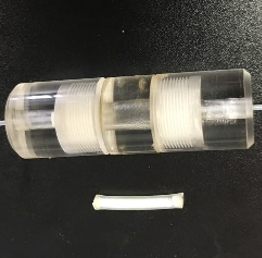The system consists of two phases: 1) Hgtot determination: a sample sample is pre-treated with a 1:1 acid mixture of HNO3 and H2O2, extraction is carried out with the aid of portable thermoblocks. The sample is then filtered and analyzed by square-wave anode stripping voltammetry (SW-ASV) using the portable potentiometer, with a solid gold electrode (SGE). This first step allows, using the technique of standard additions, to determine Hgtot.
2) Determination of Hgin : for speciation the extraction process is carried out using HCl, the complex chlorine mercury species forming HgCl42- and CH3HgCl; the supernatant is passed through a column packed with anionic exchange resin patented by us, CYXAD (obtained by the chemical modification of a commercial resin with an ionic liquid): Hgin is retained by the resin while CH3Hg elutes from the column. Subsequently, Hgin is eluted using HNO3 and analyzed. The concentration of CH3Hg is then calculated as the «difference» between Hgtot and Hgin.
The whole procedure was validated by analysing a certified reference material, Tuna Fish ERM-CE 464 ([Hgtot] = 5.24 +/- 0.10 mg/kg; [CH3Hg] = 5.50 +/- 0.10 mg/kg). The procedure was then tested on real samples of fresh fish, mussels, canned fish, comparing the results obtained with the method proposed with those obtained with the official methodic DMA.














